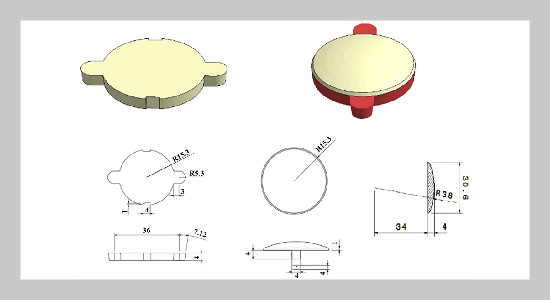- [1] S. Kitayama, S. Hashimoto, M. Takano, Y. Yamazaki, Y. Kubo, and S. Aiba, (2020) “Multi-objective optimiza�tion for minimizing weldline and cycle time using variable injection velocity and variable pressure profile in plastic injection molding" The International Journal of Ad�vanced Manufacturing Technology 107: 3351–3361. DOI: 10.1007/s00170-020-05235-8.
- [2] H. Niu, T. Hou, Y. Chen, et al., (2022) “Research On Energy-saving Operation Of High-speed Trains Based On Improved Genetic Algorithm" Journal of Applied Science and Engineering 26(5): 663–673. DOI: 10.6180/jase.202305_26(5).0009.
- [3] X. Xiao, Y. Wang, X. He, Q. Li, H. Li, et al., (2019) “De�sign and Simulation Analysis of an Energy Regenerative Electromagnetic Shock Absorber for Vehicles" Journal of Applied Science and Engineering 22(4): 625–636. DOI: 10.6180/jase.201912_22(4).0004.
- [4] A. Elduque, D. Elduque, C. Javierre, Á. Fernández, and J. Santolaria, (2015) “Environmental impact anal�ysis of the injection molding process: analysis of the pro�cessing of high-density polyethylene parts" Journal of Cleaner Production 108: 80–89. DOI: 10.1016/j.jclepro.2015.07.119.
- [5] T. Spiering, S. Kohlitz, and H. Sundmaeker. “Ad�vanced Product and Process Design Through Methodological Analysis and Forecasting of Energy Consumption in Manufacturing”. In: Advances in Sus�tainable and Competitive Manufacturing Systems: 23rd International Conference on Flexible Automation & In�telligent Manufacturing. Springer. 2013, 29–43. DOI: 10.1007/978-3-319-00557-7_3.
- [6] H. Mianehrow and A. Abbasian, (2017) “Energy monitoring of plastic injection molding process running with hydraulic injection molding machines" Journal of Cleaner Production 148: 804–810. DOI: 10.1016/j. jclepro.2017.02.053.
- [7] J. Madan, M. Mani, J. H. Lee, and K. W. Lyons, (2015) “Energy performance evaluation and improvement of unit�manufacturing processes: injection molding case study" Journal of Cleaner Production 105: 157–170. DOI: 10.1016/j.jclepro.2014.09.060.
- [8] M. Paolucci, D. Anghinolfi, and F. Tonelli, (2017) “Fac�ing energy-aware scheduling: a multi-objective extension of a scheduling support system for improving energy ef�ficiency in a moulding industry" Soft Computing 21: 3687–3698. DOI: 10.1007/s00500-015-1987-8.
- [9] T. Spiering, S. Kohlitz, H. Sundmaeker, and C. Her�rmann, (2015) “Energy efficiency benchmarking for in�jection moulding processes" Robotics and Computer�Integrated Manufacturing 36: 45–59. DOI: 10.1016/j.rcim.2014.12.010.
- [10] F. Hentati, I. Hadriche, N. Masmoudi, and C. Bradai, (2019) “Optimization of the injection molding process for the PC/ABS parts by integrating Taguchi approach and CAE simulation" The International Journal of Advanced Manufacturing Technology 104: 4353– 4363. DOI: 10.1007/s00170-019-04283-z.
- [11] M. Tian, X. Gong, L. Yin, H. Li, W. Ming, Z. Zhang, and J. Chen, (2017) “Multi-objective optimization of injection molding process parameters in two stages for multiple quality characteristics and energy efficiency us�ing Taguchi method and NSGA-II" The International Journal of Advanced Manufacturing Technology 89: 241–254.
- [12] Y.-g. Peng, J. Wang, and W. Wei, (2014) “Model pre�dictive control of servo motor driven constant pump hy�draulic system in injection molding process based on neu�rodynamic optimization" Journal of Zhejiang Univer�sity Science C 15(2): 139–146.
- [13] H. S. Park and T. T. Nguyen, (2014) “Optimization of injection molding process for car fender in considera�tion of energy efficiency and product quality" Journal of Computational Design and Engineering 1(4): 256–265.
- [14] W. Li, S. Kara, and F. Qureshi, (2015) “Characterising energy and eco-efficiency of injection moulding processes" International journal of sustainable engineering 8(1): 55–65.
- [15] H.-S. Park, X.-P. Dang, D.-S. Nguyen, and S. Kumar, (2020) “Design of advanced injection mold to increase cooling efficiency" International Journal of Precision Engineering and Manufacturing-Green Technology 7: 319–328.
- [16] Y. Cao, X. Fan, Y. Guo, S. Li, and H. Huang, (2020) “Multi-objective optimization of injection-molded plastic parts using entropy weight, random forest, and genetic algorithm methods" Journal of Polymer Engineering 40(4): 360–371.
- [17] M. Huszar, F. Belblidia, H. M. Davies, C. Arnold, D. Bould, and J. Sienz, (2015) “Sustainable injection mould�ing: The impact of materials selection and gate location on part warpage and injection pressure" Sustainable Materials and Technologies 5: 1–8.
- [18] P. S. Minh, H.-S. Dang, and N. C. Ha, (2023) “Op�timization of 3D cooling channels in plastic injection molds by Taguchi-integrated principal component analysis (PCA)" Polymers 15(5): 1080.
- [19] J. Wang, C. Hopmann, M. Schmitz, T. Hohlweck, and J. Wipperfürth, (2019) “Modeling of pvT behavior of semi-crystalline polymer based on the two-domain Tait equation of state for injection molding" Materials & De�sign 183: 108149.
- [20] G. F. Nama, D. Despa, et al. “Real-time monitoring system of electrical quantities on ICT Centre building University of Lampung based on Embedded Single Board Computer BCM2835”. In: 2016 International Conference on Informatics and Computing (ICIC). IEEE. 2016, 394–399.
- [21] G. Senthilkumar, T. Mayavan, R. Murugan, G. Gnanakumar, et al., (2022) “Multi Objective Optimiza�tion Of Process Parameters For Friction Welded EN 10028 P 355 GH Steel And AISI 430 Steel Joint By GRG Rein�forced Response Surface Methodology" Journal of Ap�plied Science and Engineering 26(9): 1215–1223.
- [22] W.-C. Chen, M.-H. Nguyen, W.-H. Chiu, T.-N. Chen, and P.-H. Tai, (2016) “Optimization of the plastic injec�tion molding process using the Taguchi method, RSM, and hybrid GA-PSO" The International Journal of Ad�vanced Manufacturing Technology 83: 1873–1886.
- [23] M.-Y. Lin, Y.-J. Zeng, S.-J. Hwang, M.-H. Wang, H.-P. Liu, and C.-L. Fang, (2023) “Warpage and residual stress analyses of post-mold cure process of IC packages" The International Journal of Advanced Manufac�turing Technology 124(3-4): 1017–1039.
- [24] R. Abdul, G. Guo, J. C. Chen, and J. J.-W. Yoo, (2020) “Shrinkage prediction of injection molded high density polyethylene parts with taguchi/artificial neural network hybrid experimental design" International Journal on Interactive Design and Manufacturing (IJIDeM) 14: 345–357.
- [25] C. Vargas-Isaza, J. Posada-Correa, and J. Briñez-de León, (2023) “Analysis of the Stress Field in Photoelas�ticity Used to Evaluate the Residual Stresses of a Plastic Injection-Molded Part" Polymers 15(16): 3377.
- [26] C. Macías, O. Meza, and E. Pérez, (2015) “Relaxation of residual stresses in plastic cover lenses with applications in the injection molding process" Engineering Failure Analysis 57: 490–498.
















